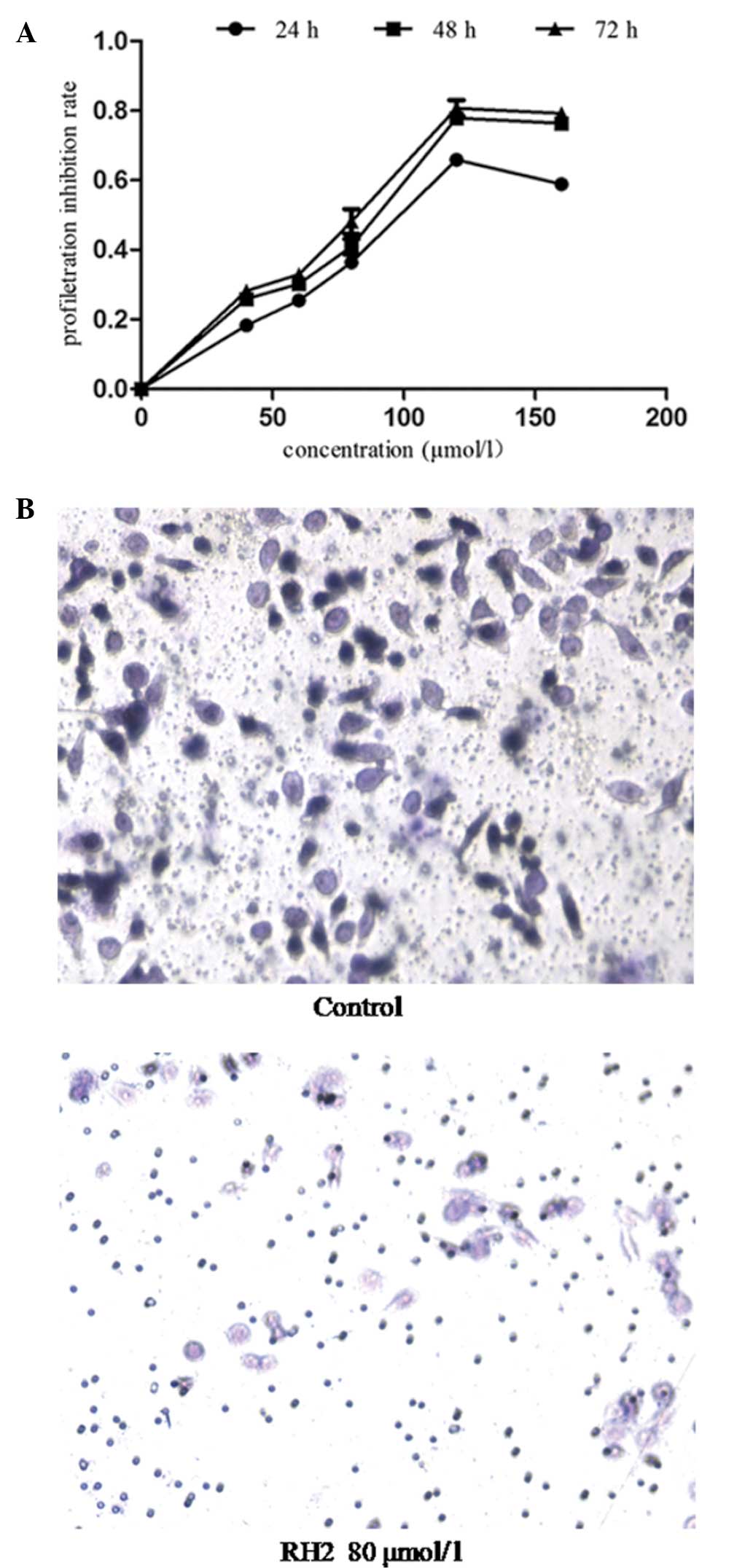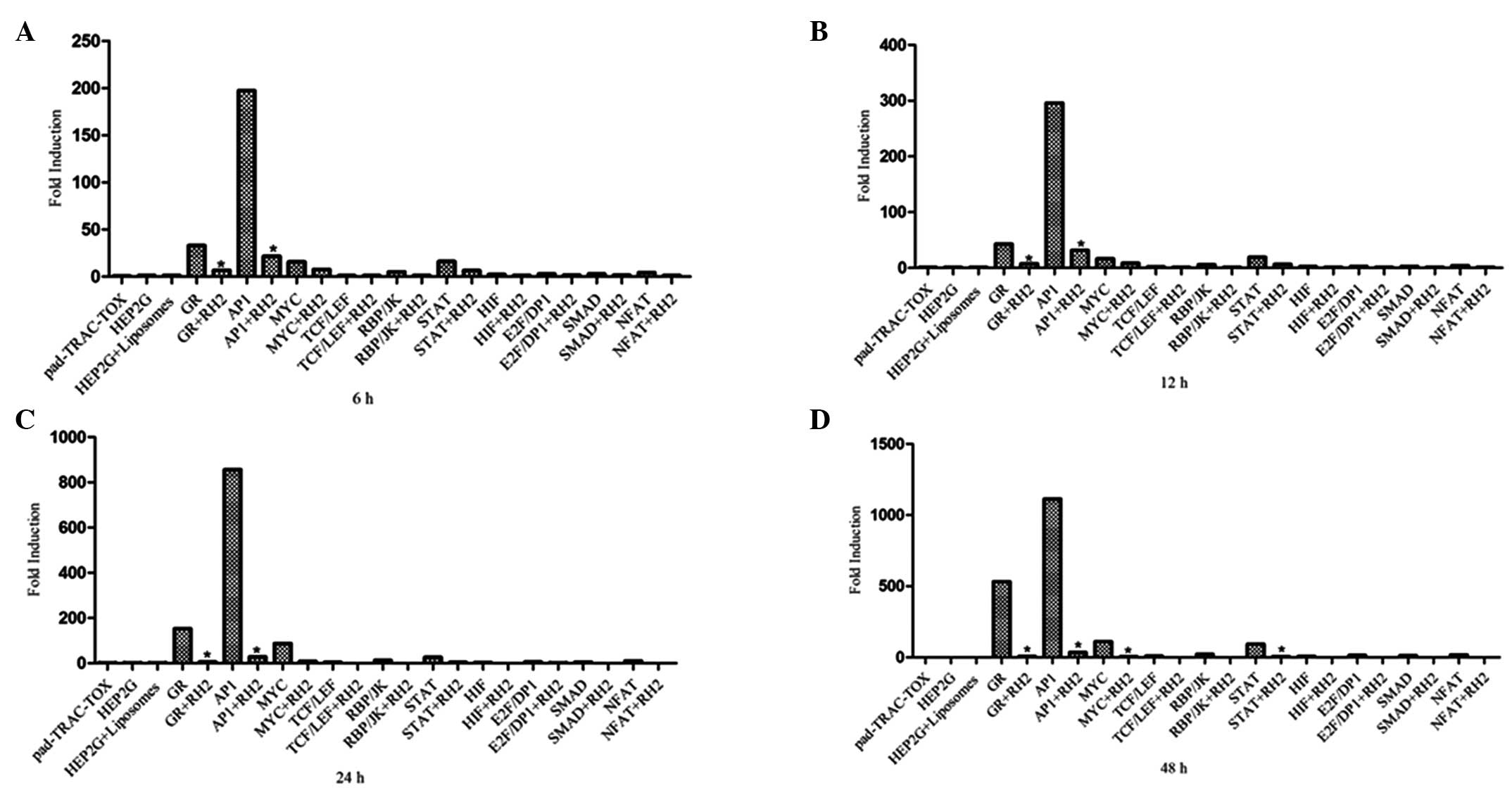|
1
|
Coradini D and Speranza A: Histone
deacetylase inhibitors for treatment of hepatocellular carcinoma.
Acta Pharmacol Sin. 26:1025–1033. 2005. View Article : Google Scholar : PubMed/NCBI
|
|
2
|
Quint K, Agaimy A, Di Fazio P, et al:
Clinical significance of histone deacetylases 1, 2, 3, and 7: HDAC2
is an independent predictor of survival in HCC. Virchows Arch.
459:129–139. 2011. View Article : Google Scholar : PubMed/NCBI
|
|
3
|
Page AJ, Cosgrove DC, Philosophe B and
Pawlik TM: Hepatocellular carcinoma: diagnosis, management, and
prognosis. Surg Oncol Clin N Am. 23:289–311. 2014. View Article : Google Scholar
|
|
4
|
Zhu Q, Zhou L, Yang Z, et al:
O-GlcNAcylation plays a role in tumor recurrence of hepatocellular
carcinoma following liver transplantation. Med Oncol. 29:985–993.
2012. View Article : Google Scholar
|
|
5
|
Ji Z, Wang T, Shao Z, et al: A
population-based study examining hepatitis B virus infection and
immunization rates in Northwest China. PLoS One. 9:e974742014.
View Article : Google Scholar
|
|
6
|
Scaggiante B, Kazemi M, Pozzato G, et al:
Novel hepatocellular carcinoma molecules with prognostic and
therapeutic potentials. World J Gastroenterol. 20:1268–1288. 2014.
View Article : Google Scholar : PubMed/NCBI
|
|
7
|
Chung KS, Cho SH, Shin JS, et al:
Ginsenoside Rh2 induces cell cycle arrest and differentiation in
human leukemia cells by upregulating TGF-β expression.
Carcinogenesis. 34:331–340. 2013.PubMed/NCBI
|
|
8
|
Christensen LP: Ginsenosides chemistry,
biosynthesis, analysis, and potential health effects. Adv Food Nutr
Res. 55:1–99. 2009.PubMed/NCBI
|
|
9
|
Tang XP, Tang GD, Fang CY, Liang ZH and
Zhang LY: Effects of ginsenoside Rh2 on growth and migration of
pancreatic cancer cells. World J Gastroenterol. 19:1582–1592. 2013.
View Article : Google Scholar : PubMed/NCBI
|
|
10
|
Wang Z, Zheng Q, Liu K, Li G and Zheng R:
Ginsenoside Rh(2) enhances antitumour activity and decreases
genotoxic effect of cyclophosphamide. Basic Clin Pharmacol Toxicol.
98:411–415. 2006. View Article : Google Scholar : PubMed/NCBI
|
|
11
|
Cheng CC, Yang SM, Huang CY, Chen JC,
Chang WM and Hsu SL: Molecular mechanisms of ginsenoside
Rh2-mediated G1 growth arrest and apoptosis in human lung
adenocarcinoma A549 cells. Cancer Chemother Pharmacol. 55:531–540.
2005. View Article : Google Scholar : PubMed/NCBI
|
|
12
|
Eferl R and Wagner EF: AP-1: a
double-edged sword in tumorigenesis. Nat Rev Cancer. 3:859–868.
2003. View
Article : Google Scholar : PubMed/NCBI
|
|
13
|
Mittelstadt ML and Patel RC: AP-1 mediated
transcriptional repression of matrix metalloproteinase-9 by
recruitment of histone deacetylase 1 in response to interferon β.
PLoS One. 7:e421522012.PubMed/NCBI
|
|
14
|
Wang L, Cheng X, Li H, et al: Quercetin
reduces oxidative stress and inhibits activation of c-Jun
N-terminal kinase/activator protein-1 signaling in an experimental
mouse model of abdominal aortic aneurysm. Mol Med Rep. 9:435–442.
2014.
|
|
15
|
Eckert RL, Adhikary G, Young CA, et al:
AP1 transcription factors in epidermal differentiation and skin
cancer. J Skin Cancer. 2013:5370282013. View Article : Google Scholar : PubMed/NCBI
|
|
16
|
Barbetti V, Gozzini A, Cheloni G, et al:
Time- and residue-specific differences in histone acetylation
induced by VPA and SAHA in AML1/ETO-positive leukemia cells.
Epigenetics. 8:210–219. 2013. View Article : Google Scholar
|
|
17
|
Zhang M, Dai C, Zhu H, et al: Cyclophilin
A promotes human hepatocellular carcinoma cell metastasis via
regulation of MMP3 and MMP9. Mol Cell Biochem. 357:387–395. 2011.
View Article : Google Scholar : PubMed/NCBI
|
|
18
|
Zhang C, Li C, Zhu M, et al: Meta-analysis
of MMP2, MMP3, and MMP9 promoter polymorphisms and head and neck
cancer risk. PLoS One. 8:e620232013. View Article : Google Scholar : PubMed/NCBI
|
|
19
|
Mendes O, Kim HT and Stoica G: Expression
of MMP2, MMP9 and MMP3 in breast cancer brain metastasis in a rat
model. Clin Exp Metastasis. 22:237–246. 2005. View Article : Google Scholar : PubMed/NCBI
|
|
20
|
Fanjul-Fernández M, Folgueras AR, Cabrera
S and López-Otín C: Matrix metalloproteinases: evolution, gene
regulation and functional analysis in mouse models. Biochim Biophys
Acta. 1803.3–19. 2010.PubMed/NCBI
|
|
21
|
Théret N, Musso O, Turlin B, et al:
Increased extracellular matrix remodeling is associated with tumor
progression in human hepatocellular carcinomas. Hepatology.
34:82–88. 2001.PubMed/NCBI
|
|
22
|
Slattery ML, John E, Torres-Mejia G, et
al: Matrix metalloproteinase genes are associated with breast
cancer risk and survival: the Breast Cancer Health Disparities
Study. PLoS One. 8:e631652013. View Article : Google Scholar
|
|
23
|
Ishii Y, Nakasato Y, Kobayashi S, Yamazaki
Y and Aoki T: A study on angiogenesis-related matrix
metalloproteinase networks in primary hepatocellular carcinoma. J
Exp Clin Cancer Res. 22:461–470. 2003.
|
|
24
|
Guo XX, Guo Q, Li Y, Lee SK, Wei XN and
Jin YH: Ginsenoside rh2 induces human hepatoma cell apoptosisvia
bax/bak triggered cytochrome C release and caspase-9/caspase-8
activation. Int J Mol Sci. 13:15523–15535. 2012. View Article : Google Scholar : PubMed/NCBI
|
|
25
|
Park HM, Kim SJ, Kim JS and Kang HS:
Reactive oxygen species mediated ginsenoside Rg3- and Rh2-induced
apoptosis in hepatoma cells through mitochondrial signaling
pathways. Food Chem Toxicol. 50:2736–2741. 2012. View Article : Google Scholar
|
|
26
|
Naylor LH: Reporter gene technology: the
future looks bright. Biochem Pharmacol. 58:749–757. 1999.
View Article : Google Scholar : PubMed/NCBI
|
|
27
|
Brasier AR, Tate JE and Habener JF:
Optimized use of the firefly luciferase assay as a reporter gene in
mammalian cell lines. Biotechniques. 7:1116–1122. 1989.PubMed/NCBI
|
|
28
|
Eckert RL, Adhikary G, Young CA, et al:
AP1 transcription factors in epidermal differentiation and skin
cancer. J Skin Cancer. 2013:5370282013. View Article : Google Scholar : PubMed/NCBI
|
|
29
|
Miotto B, Sagnier T, Berenger H, Bohmann
D, Pradel J and Graba Y: Chameau HAT and DRpd3 HDAC function as
antagonistic cofactors of JNK/AP-1-dependent transcription during
Drosophila metamorphosis. Genes Dev. 20:101–112. 2006.
View Article : Google Scholar : PubMed/NCBI
|
|
30
|
Correia AL, Mori H, Chen EI, Schmitt FC
and Bissell MJ: The hemopexin domain of MMP3 is responsible for
mammary epithelial invasion and morphogenesis through extracellular
interaction with HSP90β. Genes Dev. 27:805–817. 2013.PubMed/NCBI
|
|
31
|
Choi MC, Cohen TJ, Barrientos T, et al: A
direct HDAC4-MAP kinase crosstalk activates muscle atrophy program.
Mol Cell. 47:122–132. 2012.PubMed/NCBI
|
|
32
|
Mendes O, Kim HT and Stoica G: Expression
of MMP2, MMP9 and MMP3 in breast cancer brain metastasis in a rat
model. Clin Exp Metastasis. 22:237–246. 2005. View Article : Google Scholar : PubMed/NCBI
|
|
33
|
Fanjul-Fernández M, Folgueras AR, Cabrera
S and López-Otín C: Matrix metalloproteinases: evolution, gene
regulation and functional analysis in mouse models. Biochim Biophys
Acta. 1803.3–19. 2010.PubMed/NCBI
|
|
34
|
Butticè G, Duterque-Coquillaud M, Basuyaux
JP, Carrère S, Kurkinen M and Stéhelin D: Erg, an Ets-family
member, differentially regulates human collagenase1 (MMP1) and
stromelysin1 (MMP3) gene expression by physically interacting with
the Fos/Jun complex. Oncogene. 13:2297–2306. 1996.PubMed/NCBI
|














